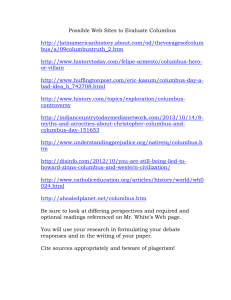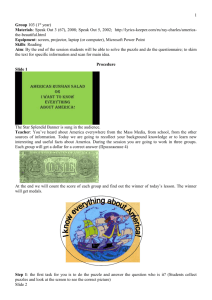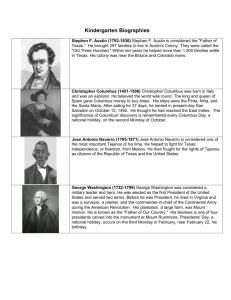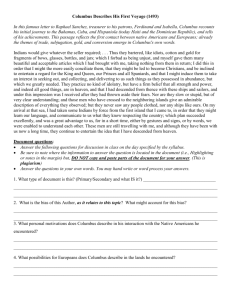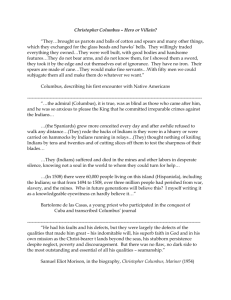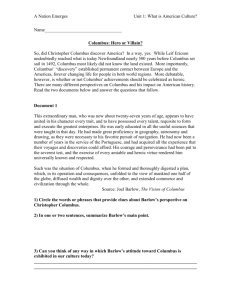After Christopher Columbus made his 1st
advertisement
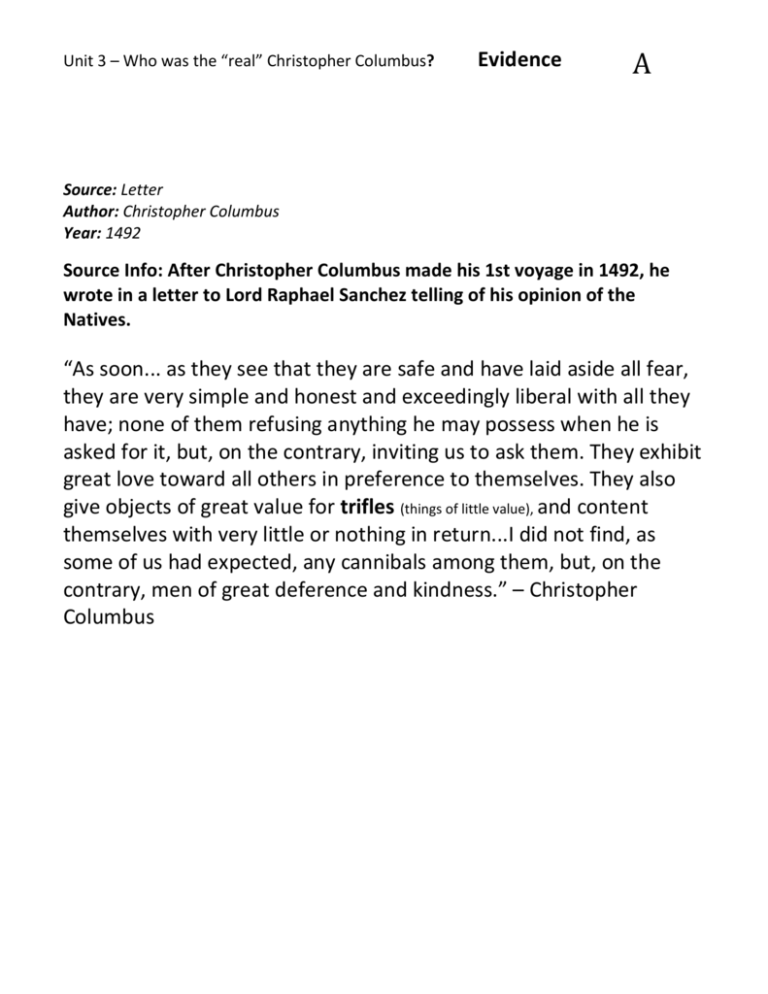
Unit 3 – Who was the “real” Christopher Columbus? Evidence A Source: Letter Author: Christopher Columbus Year: 1492 Source Info: After Christopher Columbus made his 1st voyage in 1492, he wrote in a letter to Lord Raphael Sanchez telling of his opinion of the Natives. “As soon... as they see that they are safe and have laid aside all fear, they are very simple and honest and exceedingly liberal with all they have; none of them refusing anything he may possess when he is asked for it, but, on the contrary, inviting us to ask them. They exhibit great love toward all others in preference to themselves. They also give objects of great value for trifles (things of little value), and content themselves with very little or nothing in return...I did not find, as some of us had expected, any cannibals among them, but, on the contrary, men of great deference and kindness.” – Christopher Columbus Unit 3 – Who was the “real” Christopher Columbus? Evidence Source: Painting Title: First landing of Columbus on the shores of the New World, at San Salvador Author: Dioscoro Teofilo Pueblo Tolin Year: 1863 B Unit 3 – Who was the “real” Christopher Columbus? Evidence C Source: Poem Author: Joel Barlow Year: 1787 Additional Info: Joel Barlow was an early American poet who lived from 1754 to 1812. The following is an excerpt from his poem The Vision of Columbus, written in 1787. This extraordinary man, who was now about twenty-seven years of age, appears to have united in his character every trait, and to have possessed every talent, requisite to form and execute the greatest enterprises. He was early educated in all the useful sciences that were taught in that day. He had made great proficiency in geography, astronomy and drawing, as they were necessary to his favorite pursuit of navigation. He had now been a number of years in the service of the Portuguese, and had acquired all the experience that their voyages and discoveries could afford. His courage and perseverance had been put to the severest test, and the exercise of every amiable and heroic virtue rendered him universally known and respected. Such was the situation of Columbus, when he formed and thoroughly digested a plan, which, in its operation and consequences, unfolded to the view of mankind one half of the globe, diffused wealth and dignity over the other, and extended commerce and civilization through the whole. Unit 3 – Who was the “real” Christopher Columbus? Evidence D Source: Textbook – A People’s History of the United States Author: Howard Zinn Year: 1980 Additional Information: Howard Zinn cites the writing of Bartolome de las Casas, a Catholic priest who moved from Spain to the New World in 1508. When he arrived on Hispaniola in 1508, Las Casas says, "there were 60,000 people living on this island, including the Indians; so that from 1494 to 1508, over three million people had perished from war, slavery, and the mines. Who in future generations will believe this? I myself writing it as a knowledgeable eyewitness can hardly believe it...." Thus began the history, five hundred years ago, of the European invasion of the Indian settlements in the Americas. That beginning, when you read Las Casas-even if his figures are exaggerations (were there 3 million Indians to begin with, as he says, or less than a million, as some historians have calculated, or 8 million as others now believe?) is conquest, slavery, death. When we read the history books given to children in the United States, it all starts with heroic adventure-there is no bloodshed-and Columbus Day is a celebration.
